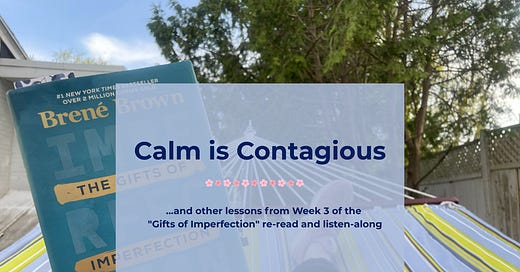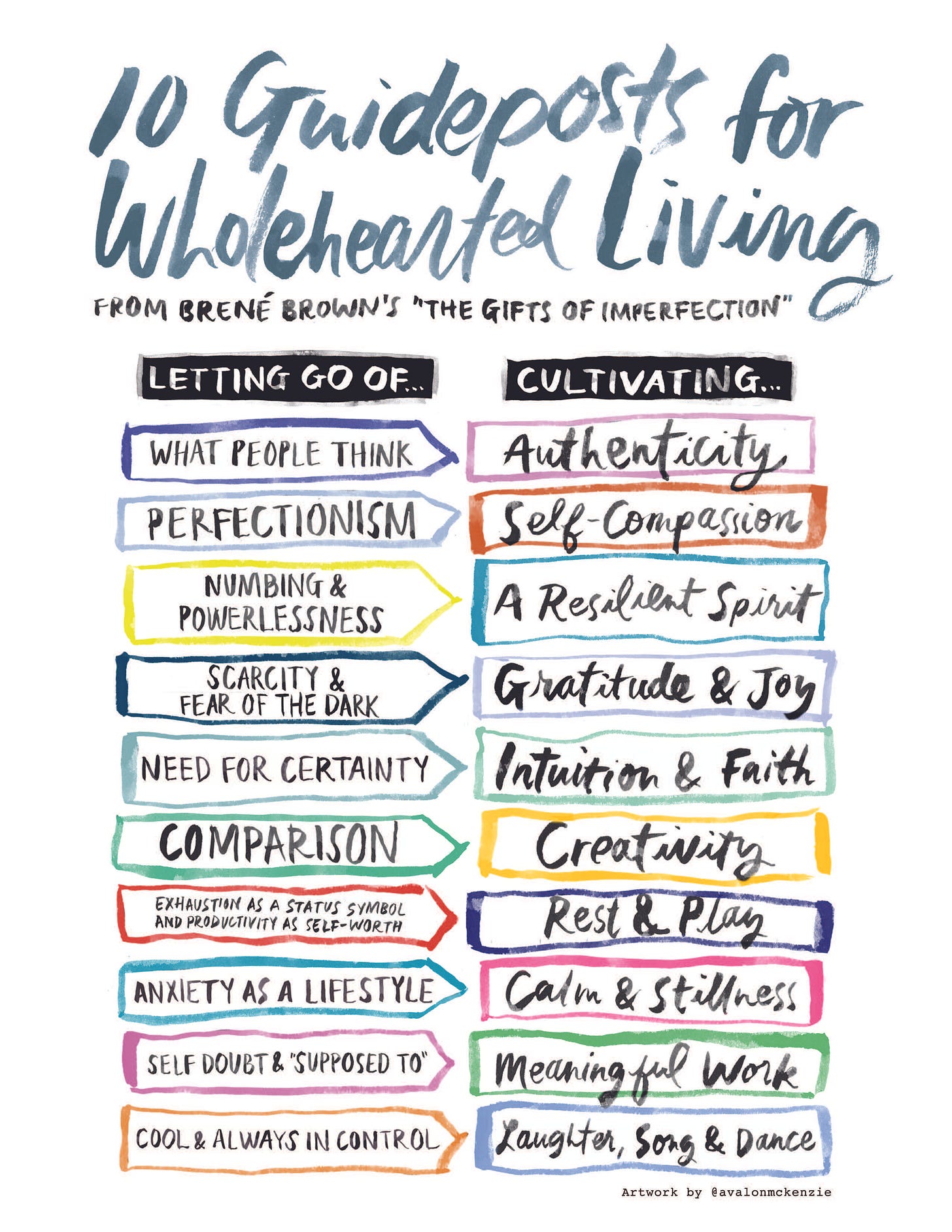Calm is Contagious
...and other lessons from Week 3 of the "Gifts of Imperfection" re-read and listen-along
Welcome! I’m Dr. Jillian, a physician leader, toddler mom, and coach who writes Humans Leading to help overwhelmed professionals live less stressed, more satisfying lives. If the full post doesn’t show up in your e-mail, come over to the webpage or Substack App to see the whole thing. Subscribe here for free to get future posts straight to your inbox:
✨ Last time: Week 2 of our 4-week journey through “The Gifts of Imperfection”: Catch up here.
✨ Today: Week 3 - takeaways from Guideposts 5-8 and podcast 4 and 5
Welcome back for Week 3 of the Gifts of Imperfection Re-Read and listen-along!
When I was recovering from burnout five years ago, I read Brené Brown’s The Gifts of Imperfection as a first step toward embracing my limitations.
A year later, I followed along with a podcast series on the same topic that she put out with her sisters. As I have been navigating my shortcomings and limitations with dealing with grief and navigating life, I found myself turning to both of these resources again. Hearing other people share their stories about grappling with these topics is comforting and encouraging.
I’m so glad you’re here with me. Digging back into this material has been so valuable, but it hasn’t been easy. Knowing there are people doing it with me is great motivation to keep going.
Here are a few more details about what today’s post (and next week) is all about:
As a reminder (or if you’re not doing the read-along), this week’s Guideposts are:
Guidepost 5: Cultivating Intuition and Trusting Faith – Letting go of the Need for Certainty
Guidepost 6: Cultivating Creativity – Letting go of Comparison
Guidepost 7: Cultivating Play and Rest – Letting go of Exhaustion as a Status Symbol and Productivity as Self-Worth
Guidepost 8: Cultivating Calm and Stillness – Letting go of Anxiety as a Lifestyle
Upcoming Reading/listening schedule and the date the post will be released on Humans Leading:
Week 4 (May 9th) Guideposts 9&10, Podcast part 6
Wrap-up post (May 23rd) featuring the lessons I’ve learned and resources to go deeper
If you’ve missed the first few weeks of this series and would like to catch up, you can find them here:
Introduction:
Week 1:
Week 2:
With 4 guideposts to cover this week, there was so much inspiring content that I could have written forever, but that would be boring for you. And that’s not how Humans Leading works. So, I tried to focus on what really hit home for me as I went along in order to pass along these takeaways to you.
Below, you’ll find:
3 lessons I’m learning as a result of this re-read/listen
My top 5 takeaways for this week
Reflection/journaling prompts
If you’re reading and listening along with me, I hope today’s piece inspires you to think about what resonates most for you in your own life.
If it’s not the right time for your own read and listen-along, no worries! I think this post (and the other posts in the series) will still be valuable for you to read through and reflect on.
Plus, I’ve included several journaling prompts/reflection questions for you at the end.
Ok, let’s dig in!
1. It’s Not Just About Unlearning
As I re-listened to podcast #5, I was struck by something that Brené shared:
This caused me to stop and think because, as I have been working on embracing wholeheartedness in my own life over the past several years, I have mostly been focusing on the “letting go of” portion rather than the “cultivating” portion.
Of course, this has been an important part of the process. Working on my perfectionism, learning to better tolerate uncertainty, becoming anxiety-aware rather than being consumed by my anxiety, and disentangling myself from the hustle of achievement culture have been transformative in my life.
However, this week I was reminded of the importance of continuing to cultivate the other side of the guideposts.
As you look through the list (or at your Wholehearted Inventory results), which things could you benefit from cultivating more of in your own life?
2. Rest and Play are Key Elements of Wellbeing
The “cultivating” portion of Guidepost 7 is one of the most challenging for me: cultivating rest and play.
As I described in this post, as recently as a few years ago, I had no idea what play looked like in my own life. And, until I experienced burnout, I was unwilling to admit how essential rest was.
Like Brené, I have a shame trigger around laziness related to the way I was raised. My family is full of hard-working people who take pride in their ability to get a lot done. We even called my dad “the fiddler” because of his complete inability to sit down and rest.
I pride myself in my ability to get a lot done as well. But I now understand that rest is essential for our wellbeing and that we need 7 different types of rest in order to truly recover.
And, thanks to The Gifts of Imperfection, I now understand that play is just as important as rest. Research shows that play helps shape our brains, foster empathy, navigate complex social groups, and is the core of creativity and innovation.
I’m glad to have my son around to motivate me to play when I don’t really feel like it. I always feel better after we do something silly, even if I don’t really feel like I have the energy for it when we are getting started.
3. Cultivating Calm is a Public Service
In Guidepost 8, Brené outlines her definition of calm:
“I define calm as creating perspective and mindfulness while managing emotional reactivity.”
In other words, being calm is about being able to bring perspective to complex (and sometimes chaotic) situations without being carried away by your emotions.
For me, learning to remain calm under extremely stressful situations has been key to being an effective leader in my job as a pediatric ICU physician. It helps me think more clearly during emergencies, and my calm spreads to other people in order to help them function more effectively as well.
In other words, calm is a public service.
But it’s not something we arrive at by default. Like most of what we are learning from this book, cultivating calm is a practice that we can get better at over time.
For me, being able to remain calm (or at least calmer than I otherwise would be) under stress has required cultivating stillness on a regular basis.
As outlined in the book, this does not mean sitting quietly without any thoughts in my head. Rather:
Stillness is “about creating a clearing. It’s opening up an emotionally clutter-free space and allowing ourselves to feel and think and dream and question.”
I regularly practice stillness in meditation, walking, and journaling.
During these activities, it’s not about clearing my thoughts completely. It’s about:
learning to relate to my thoughts and my emotions differently
learning to cultivate the space needed to respond rather than to react
getting rid of mental clutter that keeps my stress response activated
If you’re looking to start cultivating calm in your own life, your breath is a great place to start.
Being calm helps at home, too.
Recently, I received a text from my husband telling me that my toddler son was a screaming, crying mess at daycare pick up, so I should be prepared for that when they arrived home.
That particular day was also challenging for me personally because I was post-call from an overnight shift (read: 16 hours in the hospital). Luckily, the night wasn’t too bad, but these shifts mean missing nearly an entire night of sleep.
This means that I am not generally my best self on these days. Instead, I can be irritable and snap at people more easily than I otherwise would. As a couple, my husband and I have implemented a “no questions policy” on these days to try to minimize the things that make me irritable or snappy.
But obviously a policy like this would never work for a young child, especially a toddler. They would never be able to understand it. And it would be unfair to not be available to my son’s needs when he was obviously having a hard time.
So, in order to try to be more like the mom I wanted to be when he arrived home that day, I needed to intentionally cultivate calm and stillness for myself before he arrived.
Daycare is approximately a 20-to-25-minute drive from our house, which wouldn’t leave me much time to get ready if I tried to cram all of my stillness practices into that time.
Instead, I’ve learned over the years that I need to schedule these practices throughout the afternoon in order to not be an irritable mess. This looks like:
eating a meal when I get up from my nap
drinking plenty of water and limiting excess caffeine
reading, journaling, or listening to an inspiring Podcast or audiobook
time outside (ideally, in the hammock now that the weather is warm enough)
moving my body- either walking outside or on the treadmill or doing yoga
These practices don’t result in perfection on my part, but they go a long way toward being able to cultivate stillness and calm inside of myself so that I can be calm for my son when he gets home.
If you’re reading along, you might notice that I skipped discussion of several parts of the Guideposts. As mentioned in the introduction of this post, there was just too much to get to.
But never fear. All of the guideposts are intertwined, and they will also be woven into the wrap-up post coming after this 4-week series is over.
Now, on to my biggest takeaways.
My top 5 from this week:
A wholehearted life is built by letting go of and by cultivating.
We all deserve and need rest.
Play is essential for our wellbeing.
Calm is contagious.
Cultivating stillness is essential for becoming calm.
If you’d like to go deeper, here are this week’s reflection/journaling questions (take what you need, leave the rest):
What unhelpful habit are you trying to unlearn, and what will you intentionally cultivate in its place?
What positive quality would you like to cultivate more of in your life? What small step could you take today to nurture this quality?
What messages did you receive about rest and play growing up? How do these messages still influence your life today?
What activities make you lose track of time in the best possible way?
How do you distinguish between numbing behaviors (scrolling, binge-watching) and true rest? What does authentic rest feel like in your body?
How does your emotional state affect those around you? Think of a recent example where your mood influenced the atmosphere in your home or workplace.
What are your personal triggers that most often disrupt your sense of calm?
How might you cultivate stillness in order to cultivate calm in your own life?



















What was your biggest takeaway from this week?
"how does your emotional state affect those around you" is something I've been thinking a lot about lately. As a leader I've noticed that how I react to things often impacts how my team will react to things. It's so important that I reflect calm to my team, because I'd rather have them feel calm then have them think they need to be anxious and stressed all the time.